
One of the many parallels to the chaos theory demonstrate how, even when everything goes terribly wrong, the result can be inherently ‘right’…for reasons that defy explanation. Such was the packed audience’s reaction to Production Illusion’s farce titled ‘Noises Off’ that opened at Al-hamra on August 5, 2010. The play was written by English playwright Michael Frayn in 1982, after he contemplated the nature of ‘backstage’ drama. According to the playwright, "It was funnier from behind than in front and I thought that one day I must write a farce from behind." Noises Off, thereby is a play within a play and being a farce rather than a comedy, it incorporates lots of physical humour and absurdity; add to that the vaudevillesque intermission music on loop and one is almost reminded of a modern day Laurel and Hardy taking the stage amid slightly more chaos. Veteran thespian Omair Rana, the director of the play (both on, off and backstage) describes it in his forwarding note to be ‘singly the most difficult and hence humbling production he ever experienced.’ One can see why, given the scope of the quite literally ‘three-dimensional’ effort. An amazing rotating set, courtesy the vision of art director Ayesha Shuja and architect Mashhad Abbas almost serves the role of a ninth character in the production. In the first act of the play the actors carry on with the dress rehearsal a day before ‘Noises On’ opens. There are missed lines, dropped cues, doors that don’t open and other doors that don’t shut! The movements and lines are repetitive enough to be ‘laugh out loud’ funny rather than witty and the audience shares the experience of being ridiculed and scolded with the actors as a pre-opening night manic director Lloyd Dallas (Omair Rana) trumps through the hall shouting cues and making actors drop their props. Needless to say it all goes downhill from that point on. The plot goes something like this: An estate agent Roger, played by Garry Long in Noises Off (Ian Eldred) brings his mistress Vicky, played by Brooke Ashton (Zainab Ahmed) to woo her without realising that the property is also playing host to an array of ‘guests’ all of whom think they are either alone or ‘not there’. The housekeeper Mrs Clackett, played by Dotty Otley and Ayesha Alam Khan tries to juggle her visitors and house owners Phillip and Flavia Brent (Freddy Fellows played by Salman Naseer and Belinda Blai played by Mina Malik) returning from their Italian honeymoon to ‘dodge’ the revenue department. Of course no farce could be complete without an aging, oft-inebriated burglar ( Saad Masood). The entire first act is an exercise in comprehension for when the on again, off again ‘actors’ take the ‘backstage’ in the second act. In the second act we see the actors backstage about to go on for a matinee performance. Each of the actors struts on to the stage (off stage for us, the audience) to spurt their lines as props are misplaced by the assistant director Poppy Norton Taylor (Fazeelat Aslam). Stage cues are repeatedly mis-announced by the other assistant director (Nadir Shami) amid a series of lover’s spats, jealous boyfriends brawling it out, tears and Selsdon trying to get drunk. The play keeps falling apart both on and off stage until it falls to pieces in the final act. In the final act, the play is near the end of its run and the friction between the actors is fast approaching boiling point. There is much improvising, glorious gaffes, an impromptu wedding and forgotten cues, lines and props. It has become common practice for plays that take place in Pakistan to receive enormous praise rather than give ‘a critical review’ and this may well be because we, the audience are simply glad to have something to take our mind off everything else. However, in the case of Noises Off, there is little criticism to be had…the play, the farce and the performances all ‘worked’. Ian Eldred delivered roaring lines and fell on stage so spectacularly the audience often held their breath wondering if he had survived. Mina Malik’s saccharine ‘darlings’ and gossip tidbits were a delight, Ayesha Alam’s Dotty was genuinely dotty enough to be lovable and Salman Naseer’s perennial nosebleeds and procrastinating pauses into the ‘meaning behind his lines’ were endearing. But as is often the case, the show belonged mostly to Rana, who opened much of his lines with ‘And God said let them remember their lines’; ‘And God said let the popcorn leave the stage and the magazine be on the stage when required’. Rana has said that his greatest hope for this play is that people come to see it and start coming to the theatre again. “That’s all I want. Rehearsals for this play started with the gruesome bombings at Data Dabar and now it is opening with the airplane crash and floods…all we hope is to add some laughter to the gruesome mix that makes up our days.” 'Noises Off' was all about timing and it was timed to perfection, near enough so that when the cast took their final bow and the power went off the audience initially thought it part of the farce. But that was when God said “let there be laughter.”








 Also impressive are the acting chops for all three players, with all three having dramatic bits strong enough to raise goose bumps.
Also impressive are the acting chops for all three players, with all three having dramatic bits strong enough to raise goose bumps.
 Rouvan, who plays the ‘pretty but slow’ soldier, is mostly convincing, especially when his character Sal starts to lose his marbles. There is a particularly chilling segment where Sal gives to a superior officer in sickening detail an account of how he committed the rape of a young girl. It was a well-played moment which evoked audible gasps from the viewing members of the audience. But while it was shocking, it was also necessary in understanding the character.
Ali and Meher are also mostly consistent, though they unfortunately take the cheaper route of screaming for dramatic effect far too often in The Man on a Black Horse. While all three actors displayed good emotional range, I feel that they can take a lesson from great theatre actors that are able to deliver powerful impact with subtle changes in facial expressions.
Rouvan, who plays the ‘pretty but slow’ soldier, is mostly convincing, especially when his character Sal starts to lose his marbles. There is a particularly chilling segment where Sal gives to a superior officer in sickening detail an account of how he committed the rape of a young girl. It was a well-played moment which evoked audible gasps from the viewing members of the audience. But while it was shocking, it was also necessary in understanding the character.
Ali and Meher are also mostly consistent, though they unfortunately take the cheaper route of screaming for dramatic effect far too often in The Man on a Black Horse. While all three actors displayed good emotional range, I feel that they can take a lesson from great theatre actors that are able to deliver powerful impact with subtle changes in facial expressions.
 Meher also had segments where she sang English numbers, though with all that screaming, it is a wonder her throat didn’t go horse… err... hoarse.
Meher also had segments where she sang English numbers, though with all that screaming, it is a wonder her throat didn’t go horse… err... hoarse.
 Facing the limitations of only three performers, cleverly, the three actors in The Man on a Black Horse adopt English accents, as opposed to American ones for the main characters, when playing supporting roles, in order to differentiate characters.
Facing the limitations of only three performers, cleverly, the three actors in The Man on a Black Horse adopt English accents, as opposed to American ones for the main characters, when playing supporting roles, in order to differentiate characters.
 Here, I was struck as to why obviously Pakistani actors were playing English and American characters, when the nationalities and politics in The Man on a Black Horse weren’t so clearly defined. Further confusing was the final act of the piece, where I frankly didn’t understand the ‘revelation’ passage of play. Though I suppose I should get back on the saddle, and go in for another viewing.
Here, I was struck as to why obviously Pakistani actors were playing English and American characters, when the nationalities and politics in The Man on a Black Horse weren’t so clearly defined. Further confusing was the final act of the piece, where I frankly didn’t understand the ‘revelation’ passage of play. Though I suppose I should get back on the saddle, and go in for another viewing.
 Even though the play started twenty minutes late, overall, the production for The Man on a Black Horse went off without a hitch. Once on stage, the actors displayed some great energy that added to the matchless experience of enjoying a play.
At the end of the performance, Ali requested that the audience spread the word about the play, if only to support the art of theatre in Pakistan.
That’s not necessary Ali, The Man on a Black Horse can stand on its own four legs.
PHOTOS: NADIR SIDDIQUI/PUBLICITY
Read more by Noman
Even though the play started twenty minutes late, overall, the production for The Man on a Black Horse went off without a hitch. Once on stage, the actors displayed some great energy that added to the matchless experience of enjoying a play.
At the end of the performance, Ali requested that the audience spread the word about the play, if only to support the art of theatre in Pakistan.
That’s not necessary Ali, The Man on a Black Horse can stand on its own four legs.
PHOTOS: NADIR SIDDIQUI/PUBLICITY
Read more by Noman 
 The curtains were raised to Akbar humming playfully on the stairs and gradually other characters emerged in the 90-minute whirlwind of wit, satire and social comment.
Was
The curtains were raised to Akbar humming playfully on the stairs and gradually other characters emerged in the 90-minute whirlwind of wit, satire and social comment.
Was  The character of Jehan Ara contains many shades - the grumpy wife who is dissatisfied at her luck in life, the suspecting wife whose radars are up for detecting any affairs her husband might have, and the subtle shade of a loving woman who secretly cares for Akbar and her husband.
The portrayal fell just a bit short of the mark however, the effort was great.
Mehboob Ahmed played by Talal Jilani:
Mehboob sahib fell abysmally short of expectations. In the actual play, Mehboob Ahmed is a perfect embodiment of culture and refinement -- what you call “chalti phirti tehzeeb” in Urdu.
This attribute is missing in the present Mehboob Ahmed, probably due to his coarse voice. Some old characters resurface in the play, including Sahafi and Shair (reminding one sorely of Moin Akhtar). Some new additions are introduced as well, like a morning show host Mehbooba.
The character of Jehan Ara contains many shades - the grumpy wife who is dissatisfied at her luck in life, the suspecting wife whose radars are up for detecting any affairs her husband might have, and the subtle shade of a loving woman who secretly cares for Akbar and her husband.
The portrayal fell just a bit short of the mark however, the effort was great.
Mehboob Ahmed played by Talal Jilani:
Mehboob sahib fell abysmally short of expectations. In the actual play, Mehboob Ahmed is a perfect embodiment of culture and refinement -- what you call “chalti phirti tehzeeb” in Urdu.
This attribute is missing in the present Mehboob Ahmed, probably due to his coarse voice. Some old characters resurface in the play, including Sahafi and Shair (reminding one sorely of Moin Akhtar). Some new additions are introduced as well, like a morning show host Mehbooba.
 The ambience:
The sets - also done by the multi-talented Yasir Hussain - gelled in perfectly with the play’s script. The house reflected its owner’s simplicity and understated lifestyle.
The power of the script and intensity of the drama did not bore audience for a second despite the single set and few characters.
The play remains brilliant as it was. The dosage of heavy Urdu is reduced, probably to accommodate new sensibilities. In the actual play, even Chaudhry sahib recites perfect Ghalib verses which sound funny due to his way of pronunciation.
In the new play, Chaudhry Sahab’s couplets are laden with mispronunciation, in a way to introduce humorous appeal. Besides, ambiguous, suggestive sentences have definitely increased a lot since the last play.
The fusion of the old and new indeed made for a great theatrical experience. The play’s unparalleled success also tells us that if a script has relevance and content, it could survive without unnecessary dramatics, songs and cheap tactics. It is good to see that although the Aangan is still Terrha, our youth is creative and entrepreneurial enough to make it livable.
PHOTOS: PUBLICITY
Read more by Samreen
The ambience:
The sets - also done by the multi-talented Yasir Hussain - gelled in perfectly with the play’s script. The house reflected its owner’s simplicity and understated lifestyle.
The power of the script and intensity of the drama did not bore audience for a second despite the single set and few characters.
The play remains brilliant as it was. The dosage of heavy Urdu is reduced, probably to accommodate new sensibilities. In the actual play, even Chaudhry sahib recites perfect Ghalib verses which sound funny due to his way of pronunciation.
In the new play, Chaudhry Sahab’s couplets are laden with mispronunciation, in a way to introduce humorous appeal. Besides, ambiguous, suggestive sentences have definitely increased a lot since the last play.
The fusion of the old and new indeed made for a great theatrical experience. The play’s unparalleled success also tells us that if a script has relevance and content, it could survive without unnecessary dramatics, songs and cheap tactics. It is good to see that although the Aangan is still Terrha, our youth is creative and entrepreneurial enough to make it livable.
PHOTOS: PUBLICITY
Read more by Samreen 
 Strings give a series of riveting performances in seven cities. Photo: Publicity[/caption]
Yes, there was such a time in this city when concerts had a wild passion in them. One wonders why such an aesthetically vibrant era was over so soon. Just think about it; it’s not like the 90’s were a time of peace in this city; there was always ethnic strife and small proxy wars going on in Karachi’s ghettos back then as well. So then what was keeping it all at bay?
Was it because back then, Pakistan’s developing music industry had realised its potential and was on its way up? Perhaps they had more opportunities to gain sponsors, which are harder to find now? Or maybe people appreciated music more back then than they do now?
I think none of these are true.
With the
Strings give a series of riveting performances in seven cities. Photo: Publicity[/caption]
Yes, there was such a time in this city when concerts had a wild passion in them. One wonders why such an aesthetically vibrant era was over so soon. Just think about it; it’s not like the 90’s were a time of peace in this city; there was always ethnic strife and small proxy wars going on in Karachi’s ghettos back then as well. So then what was keeping it all at bay?
Was it because back then, Pakistan’s developing music industry had realised its potential and was on its way up? Perhaps they had more opportunities to gain sponsors, which are harder to find now? Or maybe people appreciated music more back then than they do now?
I think none of these are true.
With the  Ahmad Ali Butt revs up the crowd at a local concert. Photo: File[/caption]
I distinctly remember, during my school days, when we would see the simple but colourful posters of concerts happening in venues like the Arts Council. We would save up money to be able to witness musicians like the
Ahmad Ali Butt revs up the crowd at a local concert. Photo: File[/caption]
I distinctly remember, during my school days, when we would see the simple but colourful posters of concerts happening in venues like the Arts Council. We would save up money to be able to witness musicians like the  A crowd cheer during a concert in Karachi. Photo: AFP[/caption]
Why are our children being made to live in a bubble? Why are they stopped from meeting their friends or attending any sort of theatre or performances even now?
The first thing that comes to mind is the cost and secondly, our own mentality acting as the biggest barrier between our kids and simple entertainment.
Event organisers need to understand that it isn’t just ‘top performances’ that will attract crowds. People will come for anything good if the ticket prices are reasonable. Once these events soar, top artists and performers will reduce their prices as well. If nothing else, it will be for the sheer energy that one can draw from a spirited crowd.
When it comes to our mentality, we need to stop thinking of the worst consequence in every possible scenario. Yes, we live in a volatile environment but that doesn’t mean that every time there is a play or concert, we should avoid going for the fear of being ‘targeted’. Can you give up your job just because you are scared you will not make it back alive? No, you can’t. In the same way that a job is a necessity, so are breaks.
[caption id="" align="alignnone" width="600"]
A crowd cheer during a concert in Karachi. Photo: AFP[/caption]
Why are our children being made to live in a bubble? Why are they stopped from meeting their friends or attending any sort of theatre or performances even now?
The first thing that comes to mind is the cost and secondly, our own mentality acting as the biggest barrier between our kids and simple entertainment.
Event organisers need to understand that it isn’t just ‘top performances’ that will attract crowds. People will come for anything good if the ticket prices are reasonable. Once these events soar, top artists and performers will reduce their prices as well. If nothing else, it will be for the sheer energy that one can draw from a spirited crowd.
When it comes to our mentality, we need to stop thinking of the worst consequence in every possible scenario. Yes, we live in a volatile environment but that doesn’t mean that every time there is a play or concert, we should avoid going for the fear of being ‘targeted’. Can you give up your job just because you are scared you will not make it back alive? No, you can’t. In the same way that a job is a necessity, so are breaks.
[caption id="" align="alignnone" width="600"] A concert featuring Noori and Karavan, along with some underground bands was held in Karachi. Photo: Publicity[/caption]
Plus, for those who still fear the worst, there are many small scale performances that take place too, for example,
A concert featuring Noori and Karavan, along with some underground bands was held in Karachi. Photo: Publicity[/caption]
Plus, for those who still fear the worst, there are many small scale performances that take place too, for example,  Although the actors are young and not as experienced as our legendary actors, their performance was delightful. Photo: File[/caption]
Although the actors are young and perhaps, not as experienced as our
Although the actors are young and not as experienced as our legendary actors, their performance was delightful. Photo: File[/caption]
Although the actors are young and perhaps, not as experienced as our Haaf Playt is based on a husband-wife relationship, where the wife constantly complains about their poor financial condition. Photo: File[/caption]
This seems ironically amusing when you think how Anwar Maqsood uses the Urdu language with such finesse in his plays. His dialogues seemed to fall on my ears like Bach’s symphony – such was their beauty. This, combined with the humour element in the play, just made it an even better experience and I was left wiping away tears of laughter.
Be warned that the humour is a little ‘out there’ but then, we were all adults there and could laugh it off in good faith.
As with all Anwar Maqsood’s plays, the story of the nagging wife and the carefree husband is sprinkled with satire based on the current situation of Pakistan. I find that these jokes never get old and in fact, it helps make an otherwise dismal situation a tad amusing, even if it is temporary.
[caption id="" align="alignnone" width="600"]
Haaf Playt is based on a husband-wife relationship, where the wife constantly complains about their poor financial condition. Photo: File[/caption]
This seems ironically amusing when you think how Anwar Maqsood uses the Urdu language with such finesse in his plays. His dialogues seemed to fall on my ears like Bach’s symphony – such was their beauty. This, combined with the humour element in the play, just made it an even better experience and I was left wiping away tears of laughter.
Be warned that the humour is a little ‘out there’ but then, we were all adults there and could laugh it off in good faith.
As with all Anwar Maqsood’s plays, the story of the nagging wife and the carefree husband is sprinkled with satire based on the current situation of Pakistan. I find that these jokes never get old and in fact, it helps make an otherwise dismal situation a tad amusing, even if it is temporary.
[caption id="" align="alignnone" width="600"] Anwar Maqsood's plays are a treat to watch. Photo: Publicity[/caption]
I cannot help but share some dialogues from the play here. This is a conversation between the whiny wife, Bano, and her happy-go-lucky husband, Iftikhar:
Anwar Maqsood's plays are a treat to watch. Photo: Publicity[/caption]
I cannot help but share some dialogues from the play here. This is a conversation between the whiny wife, Bano, and her happy-go-lucky husband, Iftikhar:

 Photo: Reuters[/caption]
Andy Serkis, widely known for his role as Gollum in Peter Jackson’s Lord of the Rings and the Hobbit trilogy, deserves an Oscar for his mesmerising
Photo: Reuters[/caption]
Andy Serkis, widely known for his role as Gollum in Peter Jackson’s Lord of the Rings and the Hobbit trilogy, deserves an Oscar for his mesmerising 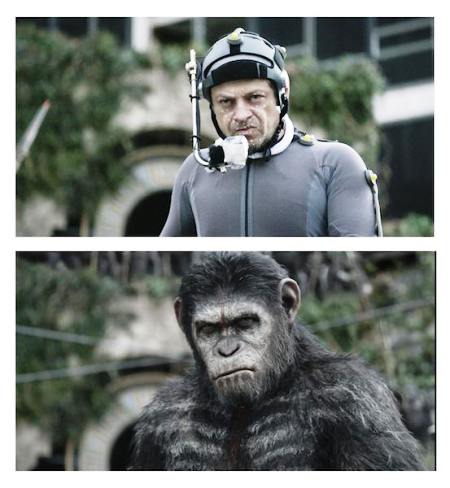 Photo: Reuters[/caption]
For those of you who might have chosen to skip the Rise of the Planet of the Apes after being mercilessly tortured by Tim Burton’s version released in 2001 starring Mark Wahlberg; I would advocate giving Dawn a chance as it was by and large the best of the ‘
Photo: Reuters[/caption]
For those of you who might have chosen to skip the Rise of the Planet of the Apes after being mercilessly tortured by Tim Burton’s version released in 2001 starring Mark Wahlberg; I would advocate giving Dawn a chance as it was by and large the best of the ‘
 Photo: Guardians of the Galaxy Facebook Page[/caption]
James Gunn had the mammoth task of bringing to life and interest virtually unknown characters; he was essentially following up previous juggernauts with an indie film. What transpired, however, is a movie that is witty, devoid of cheesy dialogue and characters that complement each other splendidly.
The protagonist, Peter Quill, (played by the lovable
Photo: Guardians of the Galaxy Facebook Page[/caption]
James Gunn had the mammoth task of bringing to life and interest virtually unknown characters; he was essentially following up previous juggernauts with an indie film. What transpired, however, is a movie that is witty, devoid of cheesy dialogue and characters that complement each other splendidly.
The protagonist, Peter Quill, (played by the lovable  Photo: Guardians of the Galaxy Facebook Page[/caption]
Bradley Cooper has been overlooked for too long; his performance as Rocket was bang on target. The one-liners by Rocket was what kept the movie going along seamlessly and the chemistry between the characters (human or Computer Generated Imagery-CGI) was commendable. The special effects were breath-taking, admittedly not on the level of say,
Photo: Guardians of the Galaxy Facebook Page[/caption]
Bradley Cooper has been overlooked for too long; his performance as Rocket was bang on target. The one-liners by Rocket was what kept the movie going along seamlessly and the chemistry between the characters (human or Computer Generated Imagery-CGI) was commendable. The special effects were breath-taking, admittedly not on the level of say,  Photo: Guardians of the Galaxy Facebook Page[/caption]
This took a large chunk of the film early on, and if you are someone who lacks patience while watching a movie, this aspect of Guardians of the Galaxy could be off-putting for you.
All in all, Guardians of the Galaxy – although way outside of Marvel’s comfort zone – still works like a charm. The on-screen chemistry from the characters, including a commendable effort from Zoe Saldana and Dave Batista keep the movie entertaining. It doesn’t have a serious and self-indulgent script and it doesn’t pretend to be something that it is not.
The movie is witty, with enough laugh-out-loud moments and on-screen chemistry; it makes you overlook its almost cavalier storytelling and character development. It is definitely a movie to watch.
Photo: Guardians of the Galaxy Facebook Page[/caption]
This took a large chunk of the film early on, and if you are someone who lacks patience while watching a movie, this aspect of Guardians of the Galaxy could be off-putting for you.
All in all, Guardians of the Galaxy – although way outside of Marvel’s comfort zone – still works like a charm. The on-screen chemistry from the characters, including a commendable effort from Zoe Saldana and Dave Batista keep the movie entertaining. It doesn’t have a serious and self-indulgent script and it doesn’t pretend to be something that it is not.
The movie is witty, with enough laugh-out-loud moments and on-screen chemistry; it makes you overlook its almost cavalier storytelling and character development. It is definitely a movie to watch.
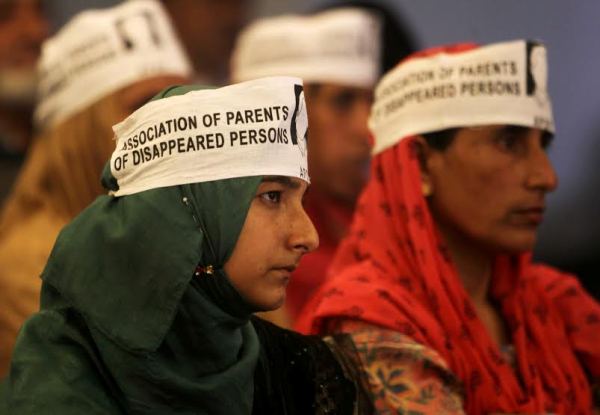 Families and relatives of those Kashmiris subjected to custodial disappearances since 1989-90. Photo: Javed Dar[/caption]
August 30 is observed as
Families and relatives of those Kashmiris subjected to custodial disappearances since 1989-90. Photo: Javed Dar[/caption]
August 30 is observed as 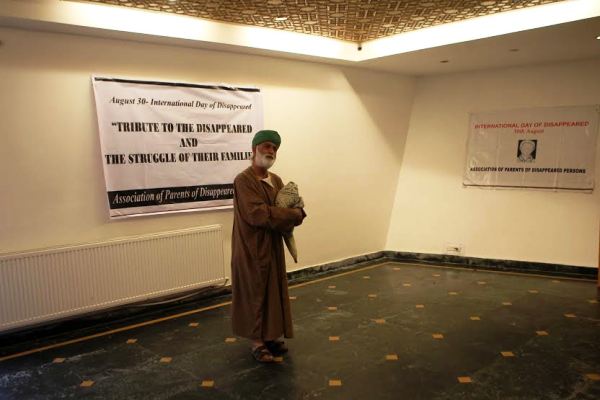 The character of old man in the play "Be te Chus Shahid" (I'm also the Witness). Photo: Javed Dar[/caption]
He goes on further to say that somewhere along the line, we find someone who makes us think; they touch our sensibility and sensitivity and by reminding all of us not to forget the process of thinking. Otherwise you know that
The character of old man in the play "Be te Chus Shahid" (I'm also the Witness). Photo: Javed Dar[/caption]
He goes on further to say that somewhere along the line, we find someone who makes us think; they touch our sensibility and sensitivity and by reminding all of us not to forget the process of thinking. Otherwise you know that  Families and relatives of those Kashmiris subjected to custodial disappearances since 1989-90. Photo: Javed Dar[/caption]
What journey, asks the boy again.
The journey I am continuing until now, the man replies.
Irritated, since he is unable to decipher anything, the boy asks him a different question,
Families and relatives of those Kashmiris subjected to custodial disappearances since 1989-90. Photo: Javed Dar[/caption]
What journey, asks the boy again.
The journey I am continuing until now, the man replies.
Irritated, since he is unable to decipher anything, the boy asks him a different question,
 Families and relatives of those Kashmiris subjected to custodial disappearances since 1989-90. Photo: Javed Dar[/caption]
Meanwhile, the old man reappears on stage and asks the young boy to return the box of letters to him.
Families and relatives of those Kashmiris subjected to custodial disappearances since 1989-90. Photo: Javed Dar[/caption]
Meanwhile, the old man reappears on stage and asks the young boy to return the box of letters to him.
 Renowned satirist-poet Zareef Ahmad Zareef speaking on the occasion of the International Day of the Disappeared. Photo: Javed Dar[/caption]
Noted paediatrician and author, Dr Altaf Hussain, said that the only demand of the Kashmiris was that a crime has been committed against humanity, not against Muslims, not against
Renowned satirist-poet Zareef Ahmad Zareef speaking on the occasion of the International Day of the Disappeared. Photo: Javed Dar[/caption]
Noted paediatrician and author, Dr Altaf Hussain, said that the only demand of the Kashmiris was that a crime has been committed against humanity, not against Muslims, not against 
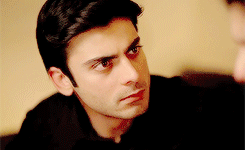 Photo: Tumblr[/caption]
2. His music
The way he plays the guitar and sings like his life depended on it. *melting*
[caption id="" align="alignnone" width="500"]
Photo: Tumblr[/caption]
2. His music
The way he plays the guitar and sings like his life depended on it. *melting*
[caption id="" align="alignnone" width="500"]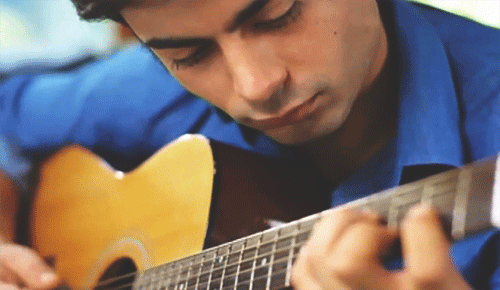 Photo: Tumblr[/caption]
3. His boy-next-door smile
The way he looks down shyly, right before he looks up at you and flashes that dreamy smile.
[caption id="" align="alignnone" width="245"]
Photo: Tumblr[/caption]
3. His boy-next-door smile
The way he looks down shyly, right before he looks up at you and flashes that dreamy smile.
[caption id="" align="alignnone" width="245"]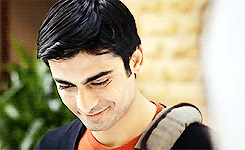 Photo: Tumblr[/caption]
4. The way he blinks
I bet you never thought blinking could look so seductive, did you? Well, look for yourself!
[caption id="" align="alignnone" width="500"]
Photo: Tumblr[/caption]
4. The way he blinks
I bet you never thought blinking could look so seductive, did you? Well, look for yourself!
[caption id="" align="alignnone" width="500"]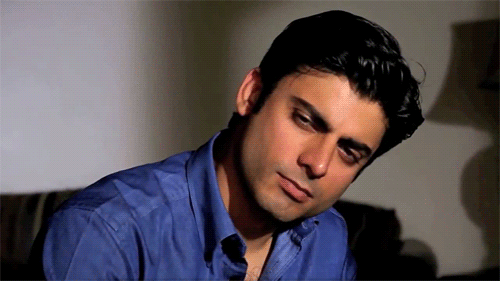 Photo: Tumblr[/caption]
5. The ideal son-in-law
He is the perfect guy to take home to your parents; with his honest, believable face and that ‘I’d do anything for you’ demeanour, I guarantee he would have your family bewitched. Yup, he’d totally burn his hand with hot chai to keep you safe.
[caption id="" align="alignnone" width="245"]
Photo: Tumblr[/caption]
5. The ideal son-in-law
He is the perfect guy to take home to your parents; with his honest, believable face and that ‘I’d do anything for you’ demeanour, I guarantee he would have your family bewitched. Yup, he’d totally burn his hand with hot chai to keep you safe.
[caption id="" align="alignnone" width="245"]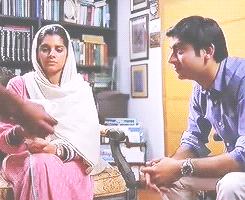 Photo: Tumblr[/caption]
6. That stubble!
OMG! OMG! OMG! That beard of his! How can
Photo: Tumblr[/caption]
6. That stubble!
OMG! OMG! OMG! That beard of his! How can  Photo: Tumblr[/caption]
7. That swagger
How he puts the entire screen on fire the minute he enters. Did I mention the suave beard?
[caption id="" align="alignnone" width="500"]
Photo: Tumblr[/caption]
7. That swagger
How he puts the entire screen on fire the minute he enters. Did I mention the suave beard?
[caption id="" align="alignnone" width="500"]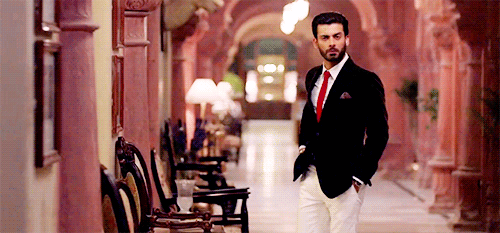 Photo: Tumblr[/caption]
8. The throaty chuckle
The way he squints his eyes, breaks into a dashing smile and surprises you further with a hearty chuckle. Yup, we’re dying.
[caption id="" align="alignnone" width="500"]
Photo: Tumblr[/caption]
8. The throaty chuckle
The way he squints his eyes, breaks into a dashing smile and surprises you further with a hearty chuckle. Yup, we’re dying.
[caption id="" align="alignnone" width="500"]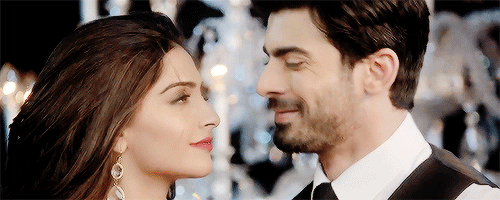 Photo: Tumblr[/caption]
9. What he wears
Whether he wears a suit, a waistcoat or a sherwani, he always looks dapper as hell, with impeccably styled hair. Though I still prefer him in a sherwani. Yup, anyday.
[caption id="" align="alignnone" width="250"]
Photo: Tumblr[/caption]
9. What he wears
Whether he wears a suit, a waistcoat or a sherwani, he always looks dapper as hell, with impeccably styled hair. Though I still prefer him in a sherwani. Yup, anyday.
[caption id="" align="alignnone" width="250"] Photo: Tumblr[/caption]
10. His modesty
Though he’s taken over social media, and the hearts of all the girls in both Pakistan and India, Fawad remains humble and blushes every time he is praised. It’s adorable!
[caption id="" align="alignnone" width="500"]
Photo: Tumblr[/caption]
10. His modesty
Though he’s taken over social media, and the hearts of all the girls in both Pakistan and India, Fawad remains humble and blushes every time he is praised. It’s adorable!
[caption id="" align="alignnone" width="500"] Photo: Tumblr[/caption]
So, now you know why we’re hopelessly, helplessly and irrevocably smitten by him and his Greek god looks. Girls are dying to just be in the same room as him and boys (0bviously) want to be him. All of us counted the hours, minutes and seconds for
Photo: Tumblr[/caption]
So, now you know why we’re hopelessly, helplessly and irrevocably smitten by him and his Greek god looks. Girls are dying to just be in the same room as him and boys (0bviously) want to be him. All of us counted the hours, minutes and seconds for 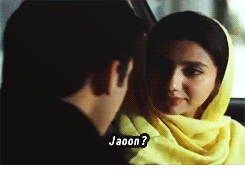 Photo: Tumblr[/caption]
After watching
Photo: Tumblr[/caption]
After watching  Photo: Khoobsurat Facebook page[/caption]
In the beginning, the pace was really fast and, personally, I think both Fawad and Sonam deserved a spicier entry (it is a Bollywood chick flick after all). Also, the scene where both their characters meet for the first time is abrupt. Had it been a stronger and funner meeting, their relationship would've seemed more interesting.
[caption id="" align="alignnone" width="595"]
Photo: Khoobsurat Facebook page[/caption]
In the beginning, the pace was really fast and, personally, I think both Fawad and Sonam deserved a spicier entry (it is a Bollywood chick flick after all). Also, the scene where both their characters meet for the first time is abrupt. Had it been a stronger and funner meeting, their relationship would've seemed more interesting.
[caption id="" align="alignnone" width="595"]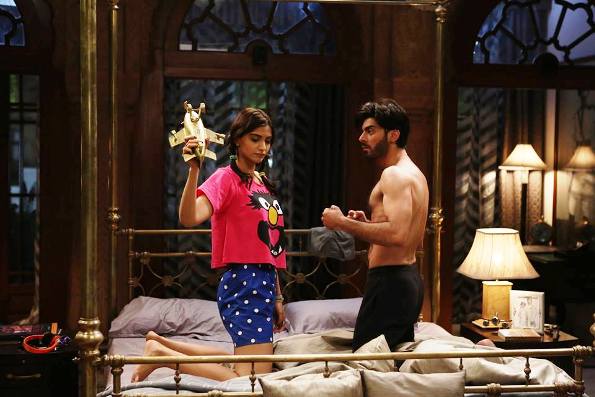 Photo: Khoobsurat Facebook page[/caption]
Another fun character was Dr Mili's mother Manju (
Photo: Khoobsurat Facebook page[/caption]
Another fun character was Dr Mili's mother Manju ( Photo: Khoobsurat Facebook page[/caption]
Sonam's character was cute and her acting was pretty likeable this time round. While she was full of energy, Fawad's character was intense and sombre, which he played perfectly.
[caption id="" align="alignnone" width="476"]
Photo: Khoobsurat Facebook page[/caption]
Sonam's character was cute and her acting was pretty likeable this time round. While she was full of energy, Fawad's character was intense and sombre, which he played perfectly.
[caption id="" align="alignnone" width="476"] Photo: Khoobsurat Facebook page[/caption]
Many reviews say that
Photo: Khoobsurat Facebook page[/caption]
Many reviews say that  Photo: Khoobsurat Facebook page[/caption]
If you compare Fawad to
Photo: Khoobsurat Facebook page[/caption]
If you compare Fawad to 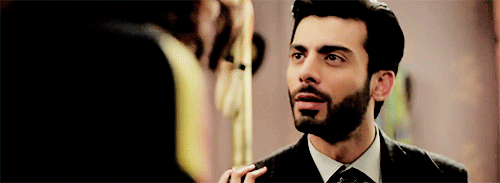 Photo: Tumblr[/caption]
2. When Sonam confesses out loud to having dirty thoughts about him and he confesses the same to himself (in his head). They both are drunk, this scene is extremely adorable!
[caption id="" align="alignnone" width="500"]
Photo: Tumblr[/caption]
2. When Sonam confesses out loud to having dirty thoughts about him and he confesses the same to himself (in his head). They both are drunk, this scene is extremely adorable!
[caption id="" align="alignnone" width="500"]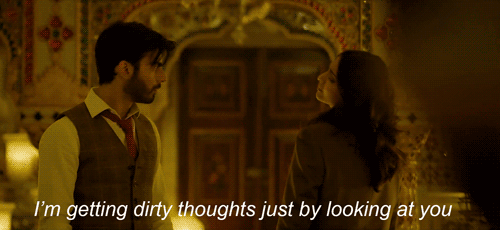 Photo: Tumblr[/caption]
3. When he sees Sonam dancing in her pjs and is shocked by her craziness. Engine ki seeti is one of the best songs of the movie.
[caption id="" align="alignnone" width="500"]
Photo: Tumblr[/caption]
3. When he sees Sonam dancing in her pjs and is shocked by her craziness. Engine ki seeti is one of the best songs of the movie.
[caption id="" align="alignnone" width="500"] Photo: Tumblr[/caption]
[embed width="620"]http://www.dailymotion.com/video/x23cpia_engine-ki-seeti-official-video-song-khoobsurat-sonam-kapoor-fawad-khan_music[/embed]
4. How throughout the movie he hates that she wears short clothes and sits ‘inappropriately’.
[caption id="" align="alignnone" width="500"]
Photo: Tumblr[/caption]
[embed width="620"]http://www.dailymotion.com/video/x23cpia_engine-ki-seeti-official-video-song-khoobsurat-sonam-kapoor-fawad-khan_music[/embed]
4. How throughout the movie he hates that she wears short clothes and sits ‘inappropriately’.
[caption id="" align="alignnone" width="500"] Photo: Tumblr[/caption]
5. The kisses – I like how they didn't make it gross and kept it adorably decent. As a random aunty sitting behind me in the cinema perfectly explained it,
Photo: Tumblr[/caption]
5. The kisses – I like how they didn't make it gross and kept it adorably decent. As a random aunty sitting behind me in the cinema perfectly explained it,
 Photo: Tumblr[/caption]
For me, he is what will sell Khoobsurat to the viewers. I don’t about you guys, but I think Fawad has made this country, and us girls in particular, really proud. So make sure you watch this movie and get smitten by the beautiful phenomenon that is Fawad Khan.
Photo: Tumblr[/caption]
For me, he is what will sell Khoobsurat to the viewers. I don’t about you guys, but I think Fawad has made this country, and us girls in particular, really proud. So make sure you watch this movie and get smitten by the beautiful phenomenon that is Fawad Khan.


 Photo: Ashfaq Wani[/caption]
[caption id="" align="alignnone" width="362"]
Photo: Ashfaq Wani[/caption]
[caption id="" align="alignnone" width="362"] Ghulam Mohiuddin Aajiz Balapora. Photo: Ashfaq Wani[/caption]
[caption id="" align="alignnone" width="578"]
Ghulam Mohiuddin Aajiz Balapora. Photo: Ashfaq Wani[/caption]
[caption id="" align="alignnone" width="578"] Photo: Ashfaq Wani[/caption]
The Ladishah is a literary type of traditional folk genre in Kashmir. It is the art of satire embedded in a song revolving around Kashmiri ethos, and is written and
Photo: Ashfaq Wani[/caption]
The Ladishah is a literary type of traditional folk genre in Kashmir. It is the art of satire embedded in a song revolving around Kashmiri ethos, and is written and  Photo: Ashfaq Wani[/caption]
[caption id="" align="alignnone" width="600"]
Photo: Ashfaq Wani[/caption]
[caption id="" align="alignnone" width="600"] Photo: Ashfaq Wani[/caption]
[caption id="" align="alignnone" width="540"]
Photo: Ashfaq Wani[/caption]
[caption id="" align="alignnone" width="540"] Photo: Ashfaq Wani[/caption]
Traditionally, the orchestra used in Bhand e Pather includes dhol (drum), sawarnai (an instrument that has a strong metallic sound with the impact of open air), nagara (an accompaniment to the dhol) and thalij (metal cymbal). The
Photo: Ashfaq Wani[/caption]
Traditionally, the orchestra used in Bhand e Pather includes dhol (drum), sawarnai (an instrument that has a strong metallic sound with the impact of open air), nagara (an accompaniment to the dhol) and thalij (metal cymbal). The  Photo: Ashfaq Wani[/caption]
[caption id="" align="alignnone" width="544"]
Photo: Ashfaq Wani[/caption]
[caption id="" align="alignnone" width="544"] Photo: Ashfaq Wani[/caption]
There are many children, from all over the valley, seen watching the plays in an effort to understand and study the
Photo: Ashfaq Wani[/caption]
There are many children, from all over the valley, seen watching the plays in an effort to understand and study the 